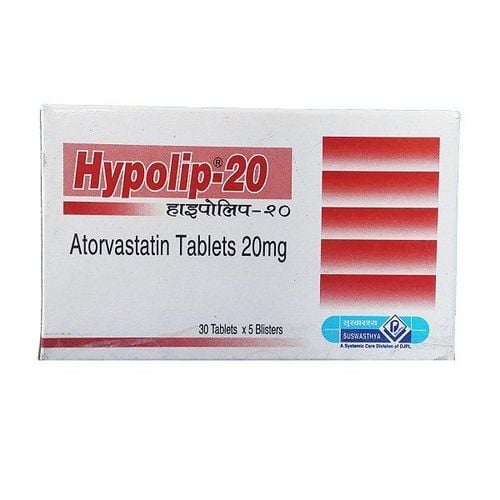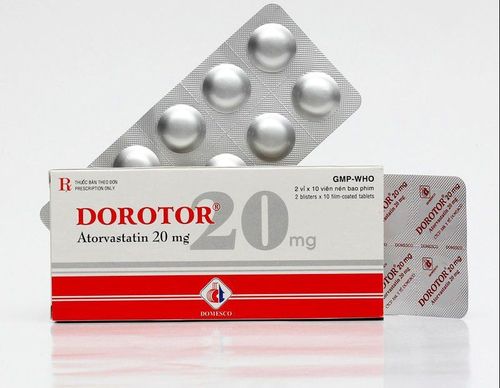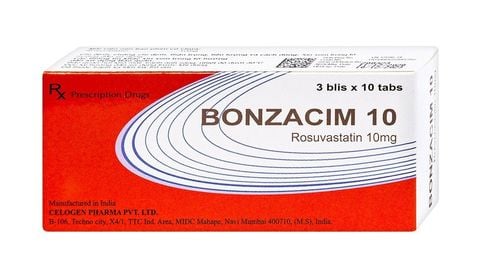This is an automatically translated article.
Vasitor 20 belongs to the group of lipid-lowering drugs, used in cases of hypercholesterolemia, high blood fat or people at risk of cardiovascular disease. Patients need to know the uses, doses and important notes during the treatment of Vasitor 20 to use the drug safely and effectively.
1. Uses of Vasitor 20
Vasitor 20 has the main ingredient Atorvastatin and excipients such as: Avicel, Lactose, Calcium carbonate, PH 102, Polysorbate-80, Magnesium stearate, Croscarmellose sodium, Hydroxypropyl methylcellulose, Propylene glycol, Titanium dioxide. Atorvastatin is a selective competitive inhibitor of HMG-CoA reductase, the enzyme responsible for the conversion of 3-hydroxy-3-methylglutaryl Coenzyme A to Mevalonate, a precursor form of sterols, including cholesterol. Atorvastatin helps to reduce total cholesterol, LDL-C and apoB in patients with familial or non-familial hypercholesterolemia and in patients with mixed dyslipidemia.
Atorvastatin also reduces VLDL-C and Triglycerides, and increases HDL-C. Cholesterol and triglycerides circulate in the blood as part of the lipoprotein complex. Clinical and pathological studies have shown that elevated plasma concentrations of total cholesterol, LDL cholesterol (LDL-C) and apolipoprotein B (Apo B) lead to atherosclerosis and is a risk factor for disease. cardiovascular disease, while increasing HDL-C reduces the risk of cardiovascular disease. Atorvastatin reduces plasma cholesterol and lipoprotein concentrations by inhibiting the enzyme HMG-CoA reductase, which inhibits cholesterol synthesis in the liver. On the other hand, by increasing the number of LDL receptors on the surface of hepatocytes, Atorvastatin increases the catabolism of LDL.
2. Indications and contraindications of Vasitor 20
2.1. Indication of the drug Vasitor 20 Used in combination with diet to reduce total cholesterol, LDL-C, apolipoprotein B and triglycerides, and increase HDL-C in patients with heterozygous primary hypercholesterolaemia familial and non-familial) and mixed dyslipidemia. Used in combination with diet for the treatment of patients with hypertriglyceridemia. Patients with primary B-lipoproteinemia for whom diet alone does not satisfy the need for treatment. Treatment of total cholesterol and LDL-C in patients with hypercholesterolemia, in combination with or in place of diet and other non-pharmacological treatments such as exercise or LDL filtration therapy. In combination with diet to reduce total cholesterol, LDL-C and apolipoprotein B in children with heterozygous familial hypercholesterolemia for whom diet alone is not sufficient. treatment or the child has a family history of premature cardiovascular disease and/or the patient's parents have two or more CVD risk factors. 2.2. Contraindications to the drug Vasitor 20 Vasitor 20 is not used in the following cases:
Patients with a history of allergy to Atorvastatin or any of its ingredients; Patients with active liver disease or unexplained elevations of serum transaminases. Pregnant or lactating women People with acute or chronic muscle diseases. Patient is taking Tipranavir + Ritonavir or Telaprevir
3. Dosage and how to use Vasitor 20
3.1. How to use Vasitor 20 is used orally. Patients should take Vasitor 20mg tablets whole, do not chew, break or crush as this can reduce the effectiveness of the drug. The drug is taken at any time of the day without regard to meals. If the patient is being treated with Amiodarone, the dose should not exceed 20 mg/day. Before starting Vasitor 20, the patient should be on a standard cholesterol-lowering diet and continue to maintain this diet throughout the course of treatment with Vasitor. 3.2. Dosage It is always recommended to start with the lowest effective dose of Vasitor 20, and then adjust the dose according to the needs and response of the individual patient, until the desired LDL cholesterol concentration or maximum dose is reached. . The minimum time required for monitoring to increase the dose is after 4 weeks. During treatment and dose adjustment of Vasitor 20, it is necessary to monitor the patient for side effects, especially those on the muscular system.
Selection of the starting dose must be individualized, based on the individual patient's cholesterol level, cardiovascular disease risk, and risk of adverse events.
Familial heterozygous hypercholesterolemia and mixed dyslipidemia:
Initial dose: 10 - 20 mg/time x 1 time/day. For people who need to reduce their LDL cholesterol by 45% or more, they can start with a dose of 40mg/day. The dose range of the drug ranges from 10 to 80 mg/day. Homozygous familial hypercholesterolemia:
Initial dose: 10 - 80mg x 1 time/day. The drug can be used as a combination or as an alternative to other lipid-lowering measures such as LDL filtration. Heterozygous familial hypercholesterolemia in children 10-17 years of age:
Recommended starting dose: 10 mg once daily Maximum dose: 20 mg/day Re-evaluate and adjust dose after 4 weeks of treatment or more
4. Undesirable effects of the drug Vasitor 20
Patients may experience some unwanted effects while using Vasitor 20 such as:
Common: diarrhea, flatulence, abdominal pain, constipation, vomiting, nausea, headache, insomnia, depression asthenia, myalgia, arthralgia, insomnia Uncommon: skin rash, myositis, cramps, paresthesia, rhinitis, peripheral neuropathy, pancreatitis, hepatitis Rare: hypersensitivity, urticaria, erythema diversity, thrombocytopenia, rhabdomyolysis Before prescribing a drug, doctors always weigh the benefits of Vasitor 20 against the risk of side effects. However, some patients may still experience unwanted effects during treatment. Therefore, if you experience unusual symptoms during treatment with Vasitor 20, you should notify your doctor or go to a medical facility for instructions on how to handle it.
5. Vasitor 20 . drug interactions
Vasitor 20 may interact if used concurrently with the following drugs and substances:
Gemfibrozil, other fibrate cholesterol-lowering drugs, Colchicine: increases the risk of muscle damage. Antiretroviral drugs such as HIV and hepatitis C drugs such as Atazanavir, Lopinavir + Ritonavir or Atazanavir + Ritonavir: rhabdomyolysis, kidney failure, kidney failure and possibly death. Phenazone: increases drug clearance Immunosuppressants, antiarrhythmics, calcium blockers: changes in plasma concentrations Digoxin: if combined with Atorvastatin at a dose of 80 mg/day may increase plasma concentrations. Digoxin to 20% Erythromycin or Clarithromycin: increased plasma concentrations of Atorvastatin
6. Be careful when using Vasitor 20
During the use of Vasitor 20, patients should note:
Use caution when using the drug in patients with risk factors for muscle damage such as people over 65 years old, uncontrolled hypothyroidism, disease Renal Before starting treatment with Atorvastatin, hypercholesterolemia due to other medical conditions such as diabetes mellitus, nephrotic syndrome, biliary cirrhosis, alcoholism, and dysproteinemia must be excluded. It is necessary to monitor blood lipid levels including total cholesterol, LDL, HDL and triglycerides before and during treatment with Vasitor 20. It is recommended that liver enzymes be tested before starting treatment with Vasitor 20 and should be rechecked. regularly during treatment. Dose reduction or drug discontinuation is required if AST or ALT is 3 times higher than normal CK test is required in the following cases: renal failure, hypothyroidism, history of liver disease or heavy alcohol consumption, personal or family history of Inherited muscle diseases, elderly people with risk factors for muscle damage. Patients need to immediately report to the doctor if they have symptoms of muscle pain, stiffness, or weakness, then they can be tested for CK and have appropriate interventions. In cases of severe acute infection, hypotension, major surgery and trauma, electrolyte disturbances, metabolic disturbances or uncontrolled convulsions, the drug should be discontinued or discontinued immediately because it increases the risk of muscle damage, muscle wasting causing secondary acute renal failure. Vasitor 20 does not affect the ability to drive and use machines. For women of childbearing age, Vasitor 20 should be used only after pregnancy has been definitively ruled out and in the event of very high blood cholesterol that has failed other treatments. Above is all information about Vasitor 20's uses, dosage and important notes when using. Vasitor 20 is a prescription drug, patients should consult their doctor if they have any questions during the use of the drug.
Please dial HOTLINE for more information or register for an appointment HERE. Download MyVinmec app to make appointments faster and to manage your bookings easily.













